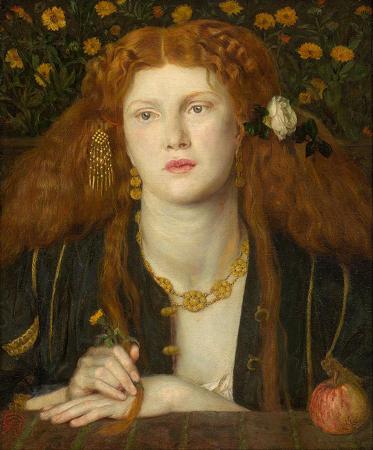Fanny Cornforth (1835 - 1909). Fanny Cornforth was an Englishwoman who became the artist's model and mistress of the Pre-Raphaelite painter Dante Gabriel Rossetti. Later, Cornforth performed the duties of housekeeper for Rossetti. William Michael Rossetti, the artist's brother, wrote that she was a pre-eminently fine woman with regular and sweet features, and a mass of the most lovely blond hair-light-golden, or 'harvest yellow'. In Rossetti's paintings, the figures modeled by Fanny Cornforth are generally rather voluptuous, differing from those of other models such as Jane Morris and Elizabeth Siddal. It is believed that Cornforth's real name was Sarah Cox, and that she was born in Steyning, West Sussex, the daughter of a blacksmith. She is recorded in the 1851 census living in Brighton, working as a house servant. Cornforth met Rossetti in 1856, and became his model and mistress in the absence of Elizabeth Siddal whom Rossetti married in 1860, under the impression that she was dying. Many biographers presumed Siddal disliked Cornforth, but there is no proof that Siddal even knew of her existence. Cornforth's first role was as to model the head of the principal figure in the painting Found, which she later described, saying he put my head against the wall and drew it for the head of the calf picture. Three months after Rossetti's wedding Cornforth married mechanic Timothy Hughes, but the relationship was short-lived. The couple separated. It is not known for certain when she adopted the name Fanny Cornforth, but Cornforth was the name of her first husband's stepfather, which she took as her surname. After Siddal's death in 1862, Cornforth moved into the widowed Rossetti's home as his housekeeper. The affair between them lasted until Rossetti's death. For much of the time Rossetti was engaged in an off-and-on relationship with Jane Morris who was married to his colleague, William Morris. Their relationship was not made public but his relationship with Cornforth was. Cornforth came from the lower/rural working class of English society. Her coarse accent and lack of education shocked Rossetti's friends and family. Rossetti's brother William Michael Rossetti praised her beauty, but said she had no charm of breeding, education, or intellect. Many never accepted her and pressured Rossetti to end the affair. Over the course of their relationship, Cornforth gained weight. Much has been made of this by biographers, but the growing girths of both Rossetti and Cornforth was a mutual joke. His pet name for her was My Dear Elephant and she called him Rhino. When they were apart, he drew cartoons of elephants and sent them to her, often signing himself Old Rhinocerous. After Rossetti's health started to decline seriously, his family became more directly involved in his life. Cornforth was forced to leave Rossetti's house in 1877. Rossetti paid for a house for her nearby, writing to her You are the only person whom it is my duty to provide for, and you may be sure I should do my utmost as long as there was a breath in my body or a penny in my purse. He gave her several of his paintings, ensuring that her legal ownership was documented. Her estranged husband had died in 1872. While separated from Rossetti, she became involved with John Schott, a publican from a family of actors. Schott divorced his first wife, who was already living in a bigamous marriage with another man, to marry her. He married Fanny almost immediately after the divorce, in November 1879. The couple ran the Rose tavern in Jermyn Street, Westminster, London. Cornforth nevertheless repeatedly returned to Rossetti to nurse him, accompanying him to Cumbria in 1881. After Rossetti's death, she and her husband opened a Rossetti gallery in 1883 to sell some of the works she owned. Her husband John died in 1891, after which she lived with her stepson Frederick. During this period she was visited by Rossetti collector Samuel Bancroft, who was able to buy from her the paintings and other memorabilia she still had. Her correspondence with Bancroft is held as part of his collection at the Delaware Art Museum. After the death of her stepson in 1898, she moved back to Sussex to stay with her husband's family. By 1905 she was apparently suffering from dementia, and was being cared for by her sister-in-law, the actress Rosa Villiers, who put her in the Workhouse in West Sussex against her will. On 30 March 1907 she was admitted to the West Sussex County Lunatic Asylum, the records of which state that she was suffering from senile mania, confusion, weak-mindedness and an inability to sustain a rational conversation, a poor memory and sleeplessness. She remained at the asylum for the rest of her life. After a fall that broke her arm in September 1907 she began to decline and contracted bronchitis in September 1908.
more...









